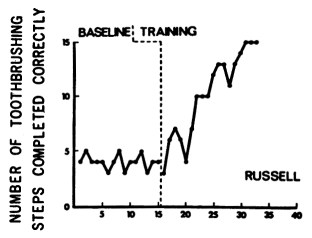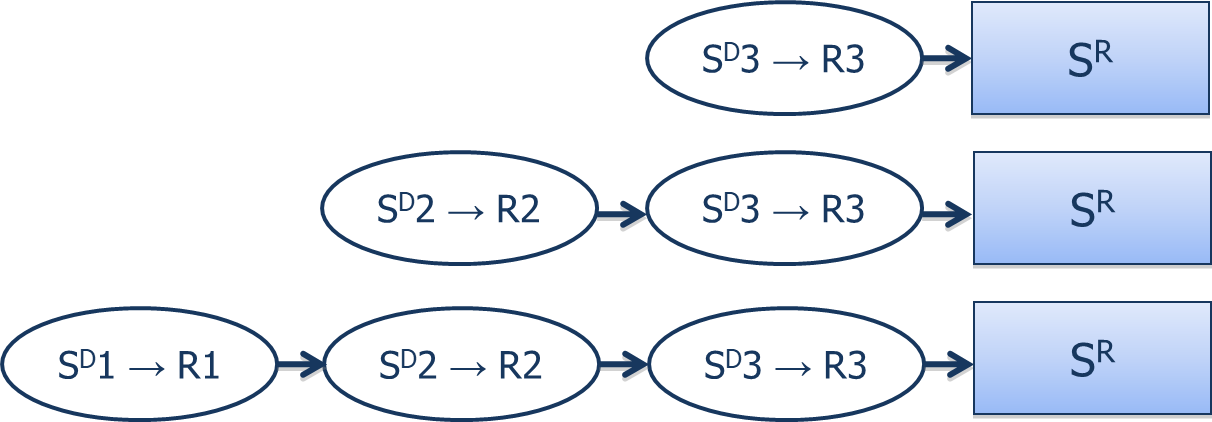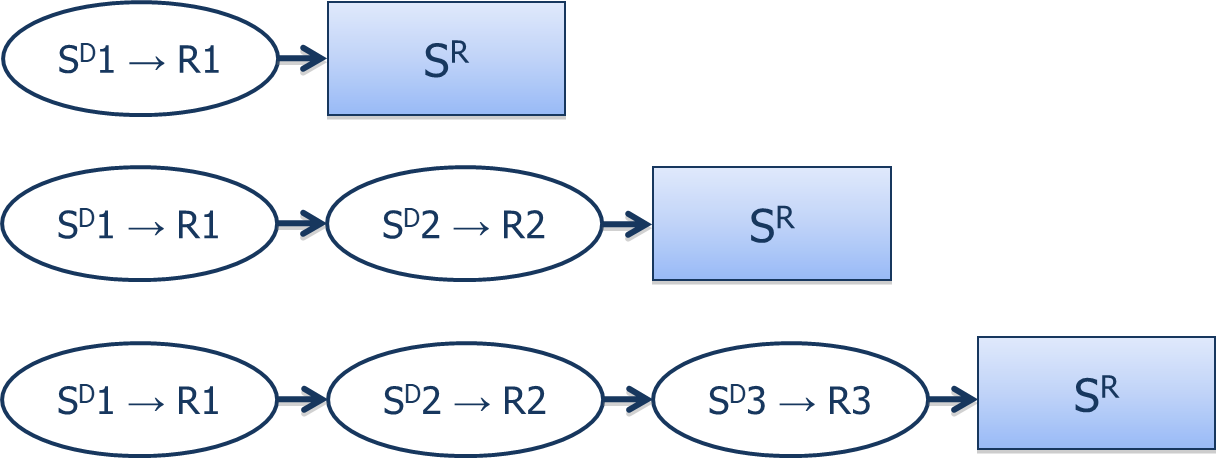
1. What is a behavioural (or stimulus-response) chain?
2. What is task analysis, and how can it be conducted?
3. Describe the three ways of teaching behavioural chains, and four self-prompting methods.
4. What factors affect performance of a behavioural chain?
5. Contrast shaping, fading, and chaining.
6. How are chaining procedures used?
How can all the steps of toothbrushing be taught?
(Horner & Keilitz, 1975)
- 9- to 17-year-olds with mild to moderate developmental disabilities
- target behaviour: brushing _____
- behavioural treatment program:
• task broken down into behavioural _____ of 15 links, starting with:
1. Pick up and hold the toothbrush
2. Wet the toothbrush
3. Remove the cap from the toothpaste
4. Apply the toothpaste to the brush
5. Replace the cap on the toothpaste
- next were three behaviors of actual brushing (brush outside/inside/biting surfaces of teeth)
- then seven behaviors for finishing up (e.g., rinse mouth, etc.)
• during training, chain was attempted from start to finish
• modeling and physical guidance prompts used
• reinforcement (______) given for each successful link
- results: learning the chain took most children from 18 to 30 sessions
- behavioural chain: complex behaviour comprised of several _________ behaviours that occur together in a certain order
- also called ________-________ chain because each behaviour produces a stimulus that acts as an SD for the next behaviour:
SD1 → R1/SD2 → R2 etc.
- final response is typically followed by _____________, although praise is often given for the successful completion of a particular link in the chain
e.g., getting gasoline (Dempsey, 2007):
1. EO (gas tank low) + SD1 (gas station sign) → R1 (exit highway)
2. SD2 (see gas station) → R2 (enter station)
3. SD3 (see pumps) → R3 (stop at pump)
4. SD4 (see nozzle) → R4 (pump gasoline)
5. SD5 (tank full) → R5 (pay at pump)
6. SD6 (tank full) → SR- (negative reinforcement: avoid empty tank)
- not all sequences of behaviour are behavioural chains
e.g., buying a textbook one day, reading it the next day, and writing an exam a week later is not a behavioural chain
- definition: identifying all antecedent stimuli and responses in the sequence that comprises a behavioural chain
- can be conducted three different ways:
1. observe someone else who is _________ at the task, while behaviour analyst records all SDs and responses
2. recruit an ______, who describes all SDs and responses, recorded by behaviour analyst
3. behaviour change agent performs the task themselves, recording all SDs and responses
- after analysis, data sheet is created, and individual’s progress is documented
- count how many links the individual completes, and _______ in that square
e.g., in the first two attempts, the person completed 3 of the links, then 2, then 4, etc.
- this creates a “_____” directly on the data sheet itself
Chaining procedures apply specific prompting and fading strategies to each stimulus-response component in the chain.
Also, an individual behavioural link in the chain may need to be ______ .
_____ ____ Presentation
- individual attempts ___ links in the chain from beginning to end
- prompting is provided for each link as required
- natural reinforcement is given only after _____ link

e.g., making PBJ sandwich:
1. get peanut butter, jam and bread
2. open peanut butter
3. open jam
4. get two slices of bread
5. spread peanut butter
6. spread jam
7. put bread slices together
8. put lid on jam
9. put lid on peanut butter
10. close bread
(eat sandwich)
- applications: PGA golfer putting, brushing teeth, riding the bus
- pros & cons:
![]() suitable for tasks that are not overly long or _______
suitable for tasks that are not overly long or _______
![]() not appropriate for people with developmental disabilities; often requires _________ guidance, which is challenging to implement
not appropriate for people with developmental disabilities; often requires _________ guidance, which is challenging to implement
________ Chaining
- prompting and fading are used to teach a complex behaviour starting with the _____ link

e.g., 1. close bread
- natural reinforcer (SR) is given after last link in the chain is completed
e.g., 1. close bread → eat sandwich
- link is repeated until learner has mastered it; all prompts are _____
- next, second-last link is added, with prompts
e.g., 1. put lid on peanut butter, 2. close bread
- ___________ reinforcer (e.g., praise) is given after second-last link is completed
- process is continued with each preceding link in the chain
- applications: getting dressed, putting together a puzzle
- pros & cons:
![]() typically used with learners who have _______ abilities; they will “complete” the chain every time (by performing the final link)
typically used with learners who have _______ abilities; they will “complete” the chain every time (by performing the final link)
![]() requires additional preparation by behaviour analyst
requires additional preparation by behaviour analyst
e.g., open the bread bag and have completed sandwich ready
_______ Chaining
- prompting and fading are used to teach a complex behaviour starting with the _____ link

e.g., 1. get peanut butter, jam and bread
- natural reinforcer is delivered only when most recently mastered link is completed
- next unmastered link in the chain is added
- conditioned reinforcer is delivered between links of the chain
- applications: writing first name, saying the alphabet, counting
- pros & cons:
![]() retains sequential order of behavioural chain
retains sequential order of behavioural chain
![]() requires additional preparation by behaviour analyst
requires additional preparation by behaviour analyst
Self-Prompting Methods
- person prompts self in order to learn the chain; does not require much ___________ from a teacher
• _______ task analysis (or textual prompts): learner uses a list of instructions that comprise the behavioural chain
e.g., recipe in a cookbook
• ____-instructions: learner recites a series of verbal prompts overtly or covertly to guide their behaviours through the chain
e.g., repeating a shopping list to yourself
• _______ prompts: learner uses photos or pictures of the product of each behaviour in the chain, or photos of a person performing each link in the chain
e.g., pictures of how to assemble a cheeseburger
• _____ modeling: learner watches a video of a model performing a link in the behavioural chain before attempting it, or watches entire video all the way through before attempting the whole chain
(Cooper et al., 2020)
• completeness of the task ________
- elements comprising the chain must be sequenced appropriately
- corresponding SDs for each response must be identified
• length or __________ of the chain
- longer or more complex chains require more training time
• schedule of reinforcement
- not all responses in a chain are affected equally by the reinforcer
e.g., in backward chaining, responses at the end of the chain are strengthened more than those at the start of the chain
- both the length of the chain and the nature of reinforcement must be considered
• ________ variation
- all possible variations of SDs likely to be encountered should be included in the training regimen
e.g., for PBJ sandwich making, present different kinds of jams, jars, breads, etc.
• ________ variation
- variations in SDs often require some change in the response to produce the same effect
e.g., varying stimulus by presenting jelly instead of jam requires different responses to get it out of the jar and onto the bread
- further training (or retraining) may be required
Gradual change procedures include shaping, fading, and chaining--all three progress _________ to produce a new behaviour
- shaping:
• shaping steps reinforce successive ______________ of the target behaviour
• training environment: unstructured situation in which learner may emit a variety of behaviours
• applies reinforcement and extinction
- fading:
• steps gradually transfer stimulus _______ from prompts to the SD
• training environment: structured situation that allows precise control of stimuli (e.g., the SD)
• applies reinforcement
- chaining:
• steps reinforce stimulus-response _____ that comprise a sequence of behaviours
• training environment: structured situation that allows stimuli and responses to be sequenced precisely
• applies reinforcement, and prompting with fading (and/or shaping)
Notes on the term “step”:
• shaping “steps” are successive approximations of one single behaviour
• three-“step” prompting refers to the procedure of using verbal, modeling, & physical guidance response prompts
• fading “steps” means the extent to which prompts are gradually eliminated over time
• “steps” in a behavioural chain are the morphologically different behaviours in a sequence; they are the “links”
1. determine whether chaining is ___________
- chaining is not appropriate when behaviour is not produced due to noncompliance
2. perform ____ ________ to determine behavioural chain
3. measure performance ________, assessing each link of the entire behavioural chain
4. select ________ procedure, depending on learner’s ability level
- ensure the links are simple enough for the person to learn quickly
- consider the use of self-prompting techniques
- learners with severe disability may require picture prompts or video modeling
- if natural reinforcement only occurs when complete chain is performed (e.g., brushing teeth, washing hands), use total task presentation instead of forward or backward chaining
5. apply behaviour _________ program
- deliver additional conditioned or unconditioned reinforcers as required
- eventually, fade prompts by the end of training
- gradually reduce the amount and/or frequency of additional reinforcement (“thinning” the schedule of programmed reinforcement); any natural reinforcement should still occur (e.g., eating the PB&J sandwich)
6. ensure behaviour is __________
e.g., provide intermittent reinforcement after the final link